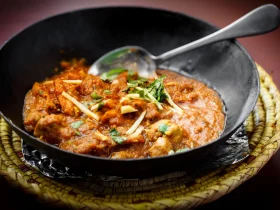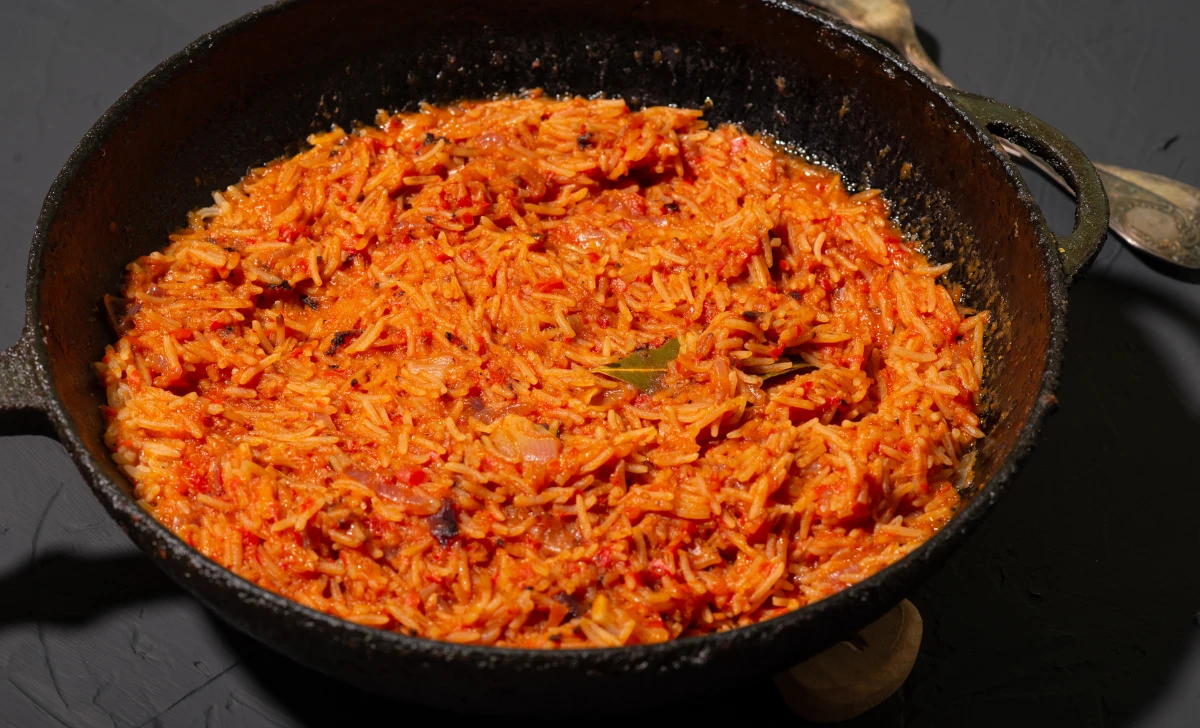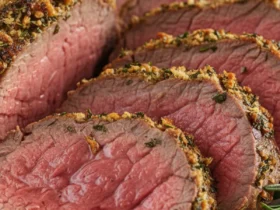Hey there, fellow food enthusiasts! Today, we’re diving into the world of Nigerian cuisine, and we’ve got something absolutely delightful on the menu – the classic Nigerian Jollof Rice! This mouthwatering dish is a true icon in West African cooking, known for its rich flavors and vibrant colors. If you’re looking to elevate your cooking game and impress your taste buds, stick around as we take you through the step-by-step process of preparing this delicious delicacy.
[ez-toc]
History
Before we delve into the recipe itself, let’s take a journey back in time to discover the fascinating history behind Nigerian Jollof Rice. This beloved dish has a storied past that reflects the diverse cultural influences of the region.
1. Origins of Jollof Rice
Jollof Rice is believed to have originated from the Senegambian region, which includes present-day Senegal and Gambia. The dish was first prepared by the Wolof people, and its name “Jollof” is derived from the Wolof word “Benachin,” meaning “one-pot” in reference to its cooking method.
2. Spread across West Africa
During the ancient trans-Saharan trade, the recipe for Jollof Rice gradually spread across West Africa, taking on unique adaptations in each region. As it traveled through different territories, local ingredients and spices were incorporated, giving rise to diverse variations of the dish.
3. Jollof Rice in Nigeria
Nigerian Jollof Rice has its own distinct identity, and it has become one of the country’s most celebrated dishes. As Nigeria embraced its independence in the 1960s, Jollof Rice played a significant role in uniting the nation through its love for food and culinary traditions.
4. Jollof Rice: A Symbol of Celebration
Over the years, Jollof Rice has become synonymous with celebrations and special occasions in Nigeria. From weddings to festivals and family gatherings, this flavorful rice dish is a centerpiece on many joyous occasions.
5. Jollof Rice Wars
Beyond its culinary significance, Jollof Rice has also sparked friendly culinary competitions known as “Jollof Rice Wars” between different West African countries. Nigerians proudly claim their version is the best, while Ghanaians, Senegalese, and others have their own devoted followers.
Time
| Step | Time (Approx.) |
|---|---|
| Prepare the Base | 15 minutes |
| Sauté the Onions and Peppers | 10 minutes |
| Add the Tomatoes and Tomato Paste | 5 minutes |
| Season with Spices | 5 minutes |
| Add the Rice and Broth | 10 minutes |
| Cook the Jollof Rice | 20 minutes |
| Optional: Add Cooked Chicken or Shrimp | 5 minutes |
| Let the Jollof Rice Rest | 5 minutes |
| Garnish and Serve | 5 minutes |
| Total Cooking and Preparation Time | 80 minutes |
Note: Cooking and preparation times may vary depending on your cooking experience and stove heat.
Ingredients
| Ingredients | Quantity (2-Person Serving) |
|---|---|
| Long-grain parboiled rice | 1 cup |
| Canned chopped tomatoes or fresh tomatoes | 200g or 3 large tomatoes |
| Onion | 1 medium-sized |
| Red bell pepper | 1/2 |
| Green bell pepper | 1/2 |
| Tomato paste | 1 tablespoon |
| Vegetable oil | 1 1/2 tablespoons |
| Chicken or vegetable broth | 1 1/2 cups |
| Garlic cloves | 1-2 |
| Thyme | 1/2 teaspoon |
| Curry powder | 1/2 teaspoon |
| Paprika | 1/2 teaspoon |
| White pepper | 1/2 teaspoon |
| Bay leaf | 1 |
| Salt | To taste |
| Optional: Cooked chicken or shrimp | 1/2 cup |
Note: The quantities mentioned above are for a 2-person serving. Adjust the measurements accordingly if you plan to cook for more or fewer people. Enjoy your cooking!
Directions
Step 1 – Prepare the Base
In a large pot or a cast-iron skillet, heat the vegetable oil over medium heat. Add the finely chopped onions and sauté them until they turn translucent and lightly golden, filling your kitchen with a delightful aroma. This usually takes around 5 minutes.
Step 2 – Sauté the Onions and Peppers
Next, add the finely chopped red and green bell peppers to the pot. Continue sautéing for another 5 minutes until the peppers become tender and add a pop of color to the dish.
Step 3 – Add the Tomatoes and Tomato Paste
Now, it’s time to bring in the tangy sweetness of tomatoes. Add either the canned chopped tomatoes or freshly blended tomatoes to the pot, along with the tomato paste. Stir everything together and let it cook for about 5 more minutes, allowing the flavors to meld beautifully.
Step 4 – Season with Spices
Enhance the taste of your Jollof Rice with a delightful blend of spices. Add minced garlic, thyme, curry powder, paprika, white pepper, and the aromatic bay leaf to the pot. Give it a good stir to ensure the spices coat the vegetables and infuse the dish with their tantalizing fragrance.
Step 5 – Add the Rice and Broth
Now comes the star of the show – the long-grain parboiled rice. Pour the rice into the pot and mix it thoroughly with the tomato and spice base. Then, add the chicken or vegetable broth, which will create the perfect, moist environment for the rice to cook to perfection.
Step 6 – Cook the Jollof Rice
Bring the mixture to a boil, then reduce the heat to low and cover the pot with a tight-fitting lid. Allow the Jollof Rice to simmer and cook for approximately 20 minutes. During this time, the rice will absorb all the flavors and transform into a luscious, orange-hued masterpiece.
Step 7 – Optional: Add Cooked Chicken or Shrimp
If you prefer your Jollof Rice with a protein boost, now’s the time to add some cooked and diced chicken or shrimp to the pot. Simply mix it in with the rice and let it warm through for about 5 minutes.
Step 8 – Let the Jollof Rice Rest
Once the rice is fully cooked and any optional proteins are added, turn off the heat and let the Jollof Rice rest for a few minutes. This resting period allows the flavors to meld even further, resulting in an even more delightful taste.
Step 9 – Garnish and Serve
Now that your classic Nigerian Jollof Rice is ready to dazzle, garnish it with some fresh chopped cilantro or parsley for a burst of freshness. Serve it with a side of fried plantains, coleslaw, or a garden salad for a complete and satisfying meal.
Enjoy the explosion of flavors and the warmth of West African cuisine as you savor every spoonful of this mouthwatering delight!
Bon appétit!
Equipment Required
Nutrition Information
| Nutrition Information | Per 1 Serving (2-Person Serving) |
|---|---|
| Serving Size | 1 cup |
| Calories | 350 kcal |
| Total Fat | 7g |
| Saturated Fat | 1g |
| Trans Fat | 0g |
| Cholesterol | 0mg |
| Sodium | 450mg |
| Total Carbohydrates | 65g |
| Dietary Fiber | 5g |
| Sugars | 6g |
| Protein | 8g |
| Vitamin D | 0mcg |
| Calcium | 50mg |
| Iron | 2mg |
| Potassium | 320mg |
Note: The nutrition information is approximate and may vary based on specific ingredients and portion sizes used. It’s always a good practice to refer to product labels and conduct your calculations for precise nutritional values. Enjoy your scrumptious meal with the comfort of knowing its nutritional content!
Tips
- Parboiled Rice: Opt for long-grain parboiled rice as it cooks evenly and has a firmer texture, ideal for absorbing the rich flavors of the dish.
- Tomatoes: If fresh tomatoes are not available, canned chopped tomatoes work just as well. Look for high-quality canned tomatoes with no added salt or preservatives.
- Rice-to-Liquid Ratio: To achieve the perfect consistency, use approximately 1.5 cups of liquid (broth) for every cup of rice.
- Broth Selection: While chicken broth is the classic choice, feel free to use vegetable broth for a vegetarian version. Both options offer delightful flavors.
- Vegetable Medley: Experiment with your favorite vegetables. Peas, carrots, and sweet corn make great additions, adding both taste and color to the dish.
- African Scotch Bonnet Pepper: For a spicier kick, include a finely chopped African Scotch Bonnet pepper. Adjust the quantity based on your spice preference.
- Low and Slow: Cooking Jollof Rice over low heat ensures that the flavors meld together perfectly and prevents burning or sticking to the pot.
- Stirring Sparingly: While cooking, avoid stirring the rice too frequently to prevent it from becoming mushy. Instead, gently fluff the rice occasionally.
- Garnish with Love: Freshly chopped cilantro or parsley adds a burst of freshness to the dish and complements the rich flavors.
Pros & Cons
| Pros | Cons |
|---|---|
| ✔️ Bursting with Flavor | ❌ Cooking Time |
| ✔️ Vibrant Colors | ❌ Slightly High Caloric Content |
| ✔️ Versatile and Customizable | ❌ Potential Stickiness of Rice |
| ✔️ Perfect for Special Occasions | ❌ Spice Level (for Some Palates) |
| ✔️ Represents Cultural Significance | ❌ Multiple Steps in Preparation |
Conclusion
In conclusion, the classic Nigerian Jollof Rice is a culinary masterpiece that embodies the vibrant flavors and rich cultural heritage of West Africa. This delightful dish, with its burst of colors and tantalizing aroma, promises to be an unforgettable addition to your dining table.
With its diverse blend of spices and customizable ingredients, Jollof Rice offers a unique and versatile experience. Whether you’re celebrating a special occasion or simply seeking a soul-warming meal, this recipe has got you covered.
Although the preparation might require some time and attention, the reward is well worth the effort. From the first bite, you’ll be transported on a flavorful journey that embraces the essence of Nigerian cuisine.
So, don your chef’s hat and embark on this culinary adventure! Get ready to impress your taste buds and your loved ones with the savory symphony of the classic Nigerian Jollof Rice. Whether you’re a seasoned cook or a beginner in the kitchen, this dish is sure to become a beloved favorite.
Give it a try, and let the delightful medley of flavors whisk you away to the heart of West Africa. Embrace the cultural significance of this iconic dish and experience the joy it brings to countless celebrations.
Remember, cooking is an art, and you have the power to infuse this recipe with your own personal touch. Don’t hesitate to experiment with different ingredients and spice levels to suit your taste preferences.
So what are you waiting for? Gather your ingredients, embrace the journey, and savor the rewards of a deliciously authentic culinary experience. Discover the magic of classic Nigerian Jollof Rice, and create cherished memories around the dinner table with friends and family.
As the saying goes, “The proof of the pudding is in the eating.” So, go ahead and take a flavorful leap into the world of Nigerian cuisine. Bon appétit!
Facts
- Fact 1: The Jollof Rice Wars – 🍚🔥
- Did you know that Jollof Rice has sparked friendly culinary battles known as the “Jollof Rice Wars”? People from different West African countries passionately debate whose version reigns supreme. It’s all in good fun, but the rivalry can get quite spicy, just like the dish itself!
- Fact 2: The Jollof Dance Challenge – 💃🏽🕺🏾
- Jollof Rice is so beloved that it inspired the “Jollof Dance Challenge” on social media. People joyfully dance to celebrate their love for this iconic dish. So, the next time you savor a plate of Jollof Rice, put on your dancing shoes and join the fun!
- Fact 3: A National Treasure – 🇳🇬🏆
- In Nigeria, Jollof Rice is more than just a dish; it’s a national treasure. So much so that there’s a World Jollof Rice Day celebrated on August 22nd every year. It’s a day filled with feasting, dancing, and celebrating the rich flavors of this West African delight!
- Fact 4: The Jollof Rice Emoji – 🍚🎉
- Jollof Rice is so iconic that it even has its own emoji! In 2017, Unicode added the Jollof Rice emoji to the list, allowing food enthusiasts worldwide to express their love for this scrumptious dish in a single character. Now, that’s emoji-nal!
- Fact 5: The “One Pot” Legacy – 🥘🌍
- The Wolof people’s influence on Jollof Rice is so profound that the name “Jollof” itself comes from the Wolof word “Benachin,” meaning “one pot.” The one-pot cooking method reflects the simplicity and communal spirit of preparing and enjoying this delicious meal together!
FAQ’s
Can I use any type of rice for Nigerian Jollof Rice?
For the best results, it’s recommended to use long-grain parboiled rice. This type of rice has a firm texture and absorbs the flavors perfectly.
Is Jollof Rice traditionally served with any side dishes?
Yes, Jollof Rice is often served with fried plantains, coleslaw, or a garden salad. These side dishes complement the dish’s flavors and add variety to the meal.
Can I make a vegetarian version of Nigerian Jollof Rice?
Absolutely! You can use vegetable broth and skip the meat or seafood. Add in your favorite vegetables and enjoy a delicious vegetarian Jollof Rice.
Is Jollof Rice a spicy dish?
The level of spiciness can be adjusted to suit your taste. Nigerian Jollof Rice can have a mild to medium spice level, depending on the amount of pepper used.
How do I prevent the rice from sticking to the pot?
To prevent sticking, make sure to use a non-stick pot or skillet. Also, avoid stirring the rice too frequently during cooking.
Can I prepare Nigerian Jollof Rice ahead of time?
Yes, you can make Jollof Rice in advance. Simply store it in an airtight container in the refrigerator and reheat it gently on the stovetop or microwave.
Can I use canned tomato sauce instead of tomato paste?
While tomato sauce can be used as a substitute, the tomato paste provides a more concentrated flavor, making it an essential ingredient for the authentic taste.
What other proteins can I add besides chicken or shrimp?
You can add cooked and diced beef, turkey, or even plant-based proteins like tofu or tempeh for a unique twist.
Can I make Jollof Rice without using any oil?
While oil adds richness to the dish, you can reduce the amount or use vegetable broth to sauté the onions and peppers for a lighter version.
Can I freeze leftover Jollof Rice?
Yes, you can freeze leftover Jollof Rice for up to 3 months. To reheat, thaw it in the refrigerator overnight and warm it in the microwave or stovetop.












Leave a Review